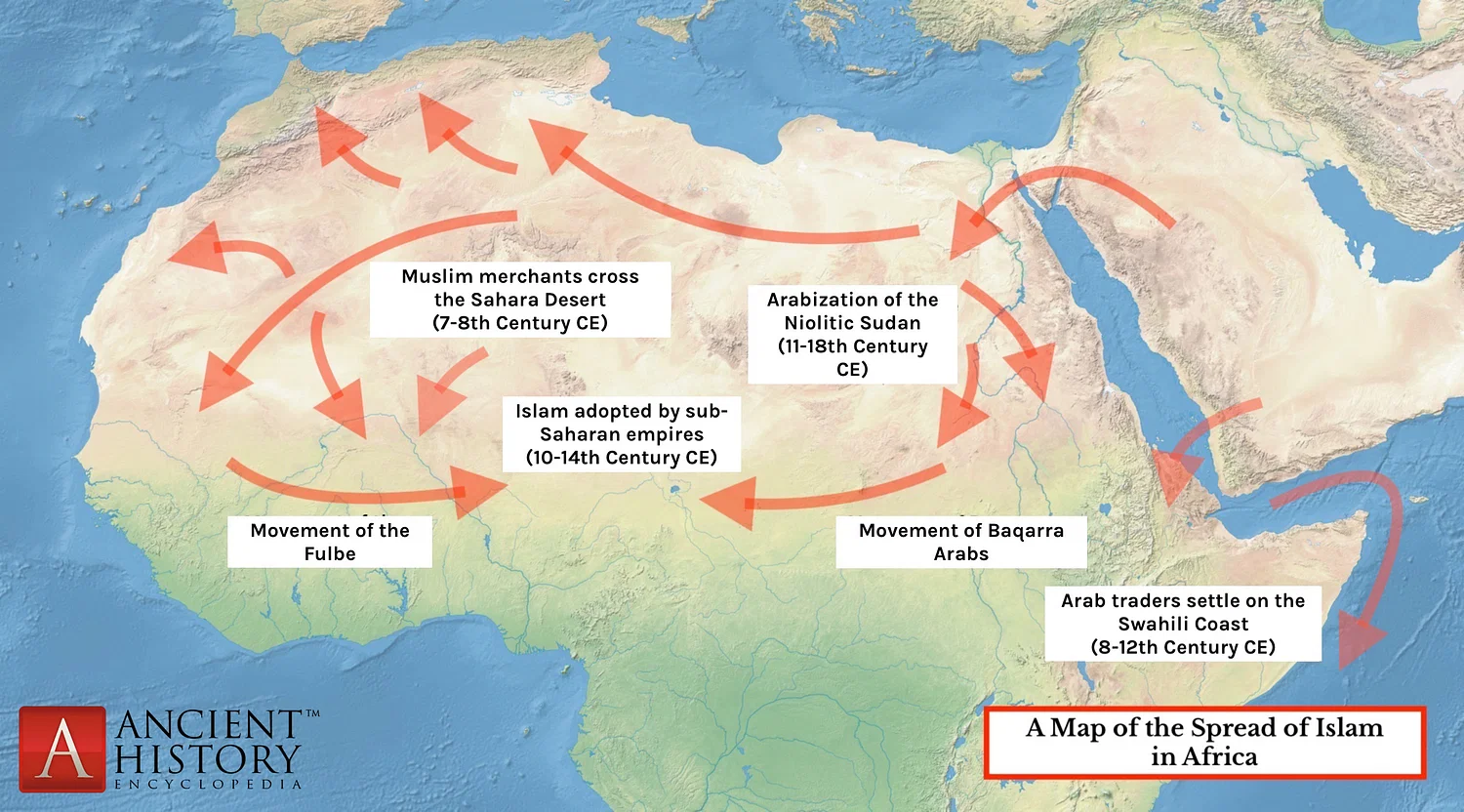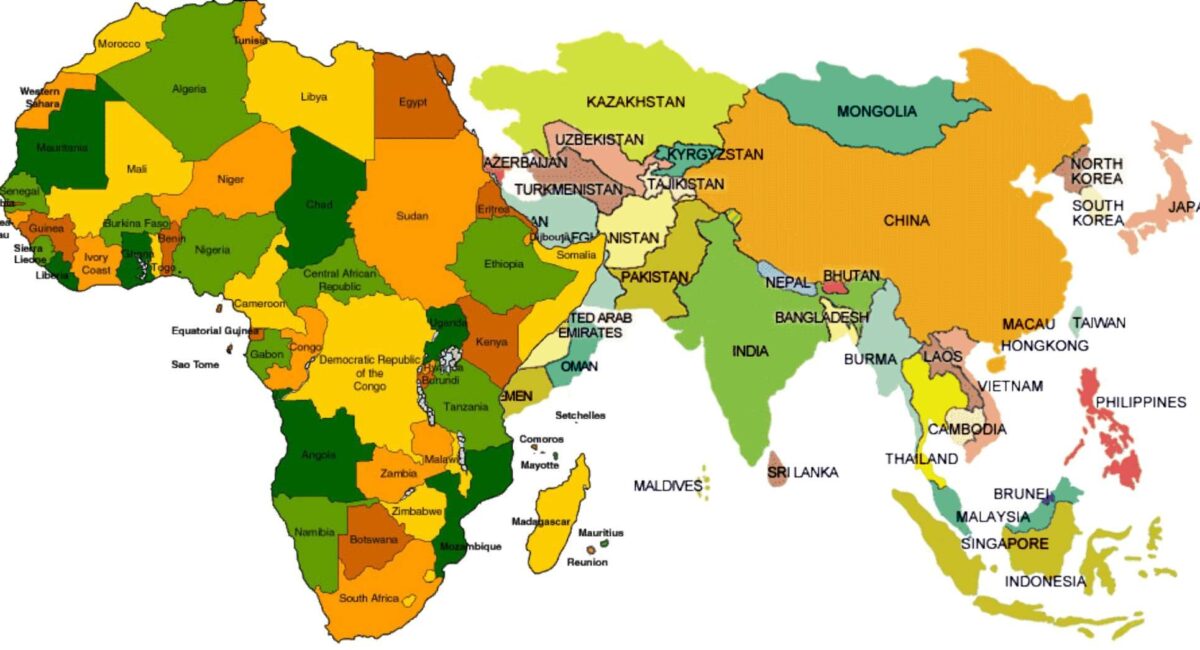Historical Interactions Between Africans, And South Asians And The Middle East
The historical interactions between South Asians, people from the Middle East, and Africans have been characterized by a complex interplay of trade, migration, cultural exchange, conflicts, colonization, imperialism, and decolonization.
Overview
Trade and Cultural Exchange
Historically, trade networks connected these regions, facilitating the exchange of goods, ideas, and cultures. The Indian Ocean served as a major trade route, fostering connections between South Asia, the Middle East, and the African coast. The exchange of spices, textiles, and other commodities enriched the cultures of these regions.
Conflicts and Slave Trades
While there were periods of cooperation and cultural exchange, there were also conflicts and exploitative practices. The trans-Saharan and Indian Ocean slave trades stand out as dark chapters in the history of these interactions. Africans were captured and traded as slaves, enduring immense suffering during their forced journeys and enslavement in foreign lands.
Colonization and Imperialism
The 19th and 20th centuries witnessed the colonization and imperialism of Africa by European powers, which significantly altered the dynamics of interactions. South Asian and Middle Eastern regions were also influenced by colonial powers, with the British Empire and others leaving their mark on these areas.
Decolonization and Shifting Dynamics
The mid-20th century saw the decolonization of Africa, leading to the emergence of independent nations. This period marked a shift in the dynamics of interactions. African countries sought to assert their independence and establish relationships with their neighbors in South Asia and the Middle East.
Religious and Ethnic Diversity
Religious and ethnic diversity in these regions has further contributed to varying attitudes and interactions. Islam, Christianity, Hinduism, and a multitude of other faiths coexist in these areas, shaping cultural and religious connections.
The Complexity of Attitudes
It is crucial to recognize that sweeping generalizations like “treat Africans badly” do not reflect the attitudes of all individuals from these regions. People’s beliefs and actions are influenced by a myriad of factors, including historical legacies, cultural backgrounds, and individual experiences.
Collaboration, Friendship, and Solidarity
Despite historical conflicts and challenges, there have been instances of collaboration, friendship, and solidarity between communities from South Asia, the Middle East, and Africa. Shared struggles for independence and social justice have fostered alliances and common goals.
In conclusion, the historical interactions between these regions are deeply nuanced and multifaceted. While there have been moments of tension and exploitation, it is essential to appreciate the diversity and complexity of these relationships. Understanding the historical context can help promote mutual respect and cooperation in our increasingly interconnected world.

People of Gujarat, India. Image from Wikipedia
Trade and Cultural Exchange
The historical interactions between South Asia, the Middle East, and Africa have been shaped by a rich tapestry of trade and cultural exchange. Over the centuries, these regions have been connected through trade networks, enabling the flow of goods, ideas, and cultures. One of the pivotal conduits of this exchange was the vast expanse of the Indian Ocean, which served as a major trade route, fostering deep connections between these diverse regions.
Indian Ocean: A Maritime Silk Road
The Indian Ocean can be aptly described as a maritime Silk Road, as it facilitated the movement of people and goods between South Asia, the Middle East, and the African coast. This extensive network of sea routes played a crucial role in the global exchange of goods, including spices, textiles, precious stones, and exotic wildlife.
Spices: The Fragrant Treasures
Spices, in particular, held a special place in the annals of trade and cultural exchange. South Asia was renowned for its rich assortment of spices, including cinnamon, cardamom, and black pepper. These fragrant treasures were highly sought after in the Middle East and Africa, not only for their culinary uses but also for their medicinal properties. The spice trade was a significant driver of cross-regional interactions, as it spurred merchants to traverse the Indian Ocean in search of these valuable commodities.
Textiles: Weaving the Fabric of Cultures
Textiles were another vital facet of this exchange. South Asian fabrics, such as intricately woven silks and fine cotton, found their way to the markets of the Middle East and Africa. These textiles were not merely commodities but also carriers of cultural expressions, reflecting the artistry and craftsmanship of their places of origin. The adoption of South Asian textiles in clothing and furnishings added a layer of aesthetic diversity to the cultural tapestry of the Middle East and Africa.
Ideas and Cultural Fusion
Beyond material goods, the exchange of ideas and cultural practices played a significant role in shaping the identity of these regions. The encounters and interactions between people from South Asia, the Middle East, and Africa fostered a cross-pollination of knowledge, traditions, and philosophies. Religious beliefs, architectural styles, and artistic expressions were shared and adapted, contributing to a dynamic cultural landscape.
Enriching the Cultures
The exchange of goods, ideas, and cultures enriched the regions involved. South Asia, the Middle East, and Africa all witnessed the fusion of diverse elements that contributed to the development of their societies. The infusion of spices into Middle Eastern and African cuisines, the incorporation of South Asian architectural motifs in Islamic and African designs, and the interplay of artistic traditions created a vibrant cultural milieu.
In conclusion, the historical interactions between South Asia, the Middle East, and Africa through trade and cultural exchange are a testament to the interconnectedness of human civilizations. The Indian Ocean, with its maritime Silk Road, served as a vital bridge that allowed the flow of goods and cultures across these regions. The exchange of spices, textiles, and ideas enriched the tapestry of human history and contributed to the diversity and vitality of these regions. This legacy of trade and cultural exchange continues to influence the contemporary identity of South Asia, the Middle East, and Africa, demonstrating the enduring impact of historical connections.
Conflicts and Slave Trades
Dark Chapters in the History of South Asia, the Middle East, and Africa
The historical interactions between South Asia, the Middle East, and Africa have been marked by a complex interplay of cooperation, cultural exchange, but also conflicts and exploitative practices. Among the darkest chapters in this shared history are the trans-Saharan and Indian Ocean slave trades, which left an indelible mark on the collective memory of these regions.
Trans-Saharan Slave Trade: A Treacherous Journey
The trans-Saharan slave trade was a harrowing episode that unfolded across the vast deserts of North Africa. Africans from sub-Saharan regions were captured and subjected to grueling journeys across the scorching sands. These captives endured treacherous conditions, including thirst, exhaustion, and exposure to the elements. Many did not survive the arduous trek, succumbing to the harsh environment and brutal treatment by their captors.
Indian Ocean Slave Trade: A Sea of Suffering
The Indian Ocean slave trade was equally devastating, with Africans being transported to various parts of the Middle East, the Indian subcontinent, and even Southeast Asia. The ocean voyage was perilous, and the cramped conditions on slave ships resulted in the spread of diseases and high mortality rates. Those who survived the journey often faced a life of unrelenting servitude in foreign lands.
Impact on African Communities
The trans-Saharan and Indian Ocean slave trades had profound and lasting impacts on African communities. The forced extraction of individuals from their homes disrupted societies and left them scarred. Families were torn apart, cultures were eroded, and economies were destabilized as a result of this human tragedy.
Legacy of Suffering
The suffering endured by the enslaved Africans during these trades is immeasurable. The legacy of pain and trauma has persisted through generations, shaping the collective memory of the affected regions. It serves as a stark reminder of the exploitation and cruelty that marred the interactions between South Asia, the Middle East, and Africa.
Calls for Acknowledgment and Reconciliation
In recent years, there have been growing calls for acknowledgment and reconciliation regarding these historical injustices. Many individuals and organizations are working to ensure that the stories of those who suffered are told and that their experiences are not forgotten. Acknowledging the past is seen as an essential step toward healing and building more equitable relationships among these regions.
The trans-Saharan and Indian Ocean slave trades are painful chapters in the shared history of South Asia, the Middle East, and Africa. While there were moments of cooperation and cultural exchange, these periods of exploitation and suffering cannot be ignored. The impact of these trades on African communities and the enduring legacy of pain emphasize the need to confront these dark chapters of history, acknowledge the suffering of those who endured them, and work toward reconciliation and a more just future.
Colonization and Imperialism
Shaping Interactions in the 19th and 20th Centuries
The 19th and 20th centuries were marked by significant global transformations, including the colonization and imperialism of Africa by European powers. These historical events had far-reaching consequences, altering the dynamics of interactions not only in Africa but also in South Asian and Middle Eastern regions. This article explores the impact of colonialism and imperialism on these areas and how European powers, particularly the British Empire, left a lasting mark.
Colonial Africa: A Continent Divided
Africa, often referred to as the “Dark Continent,” became a focal point of European colonial ambitions. During the infamous scramble for Africa, European powers such as Britain, France, Belgium, and Germany laid claim to vast territories. The carving of Africa into artificial borders, often disregarding ethnic and cultural boundaries, has had enduring implications. The colonial powers exploited Africa’s resources, leading to economic disparities and leaving a legacy of political instability.
South Asia: The Jewel in the British Crown
The British Empire, in its quest for dominance, extended its reach to the Indian subcontinent. South Asia, often described as the “Jewel in the Crown” of the British Empire, became a critical center of imperial influence. The British East India Company played a pivotal role in establishing British authority over India. The impact of British colonialism in South Asia was profound, as it reshaped the region’s economic, political, and social structures.
Middle East: Imperial Interests
The Middle East, too, was not immune to the influence of colonial powers. European imperial interests intersected with the complex geopolitical landscape of the region. The disintegration of the Ottoman Empire after World War I saw European powers gaining influence and control over parts of the Middle East. The Sykes-Picot Agreement, for instance, divided the region into spheres of influence, primarily controlled by Britain and France. The consequences of these imperial decisions continue to shape the Middle East’s modern geopolitics.
Cultural and Social Transformations
Colonization and imperialism had not only political and economic ramifications but also profound cultural and social effects. The introduction of Western educational systems, languages, and customs left indelible marks on the colonized societies. These influences continue to shape contemporary cultural landscapes in Africa, South Asia, and the Middle East.
Legacy of Colonialism
The legacy of colonialism and imperialism is complex. While it brought about infrastructural developments and modernization in some areas, it also perpetuated inequality and exploitation. Post-independence struggles for self-determination and decolonization movements reshaped the political landscape in many of these regions. However, the scars of colonialism, including ethnic and religious tensions, persist.
The colonization and imperialism of Africa, South Asia, and the Middle East by European powers, particularly the British Empire, were defining features of the 19th and 20th centuries. These events had profound and lasting impacts, influencing not only the political and economic structures but also the cultural and social landscapes of these regions. As these areas continue to grapple with the legacy of colonialism, it is essential to understand the historical forces that have shaped their interactions and destinies.
Decolonization and Shifting Dynamics: The Quest for Independence
The mid-20th century witnessed a transformative period in history marked by the decolonization of Africa. This significant event led to the emergence of independent nations and triggered a profound shift in the dynamics of interactions, not only within Africa but also in its relationships with South Asia and the Middle East. In this article, we explore the complexities and consequences of decolonization and the subsequent reshaping of interactions.
Africa: The Quest for Independence
The decolonization of Africa was a multifaceted process that occurred in the aftermath of World War II. African nations, inspired by the principles of self-determination and anti-colonial movements, began to assert their independence from European colonial powers. This wave of independence movements led to the dismantling of colonial rule and the emergence of sovereign African nations.
The Birth of Independent Nations
Between the late 1940s and the 1960s, a wave of African nations achieved independence. Leaders like Kwame Nkrumah of Ghana, Jomo Kenyatta of Kenya, and Nelson Mandela of South Africa played pivotal roles in the struggle for freedom. These leaders and their compatriots sought to establish nations with self-governance, sovereignty, and a vision for the future. The emergence of independent nations fundamentally transformed the political and social landscape of the African continent.
Challenges of Nation-Building
While independence was a momentous achievement, it also brought forth a set of challenges. The newly independent African nations faced the task of nation-building. They had to establish political systems, economies, and infrastructures to support their populations. This process was often marked by political instability, economic hardships, and struggles to balance the demands of diverse ethnic and cultural groups.
Interactions with South Asia
The decolonization of Africa had repercussions beyond the continent. African nations sought to establish relationships with their neighbors in South Asia. India, in particular, played a prominent role in supporting African independence movements. Leaders like Jawaharlal Nehru and Mahatma Gandhi advocated for African self-determination and provided moral and material support to emerging African nations. The Bandung Conference in 1955 marked a significant moment of solidarity between Asian and African countries.
Challenges in the Middle East
The dynamics in the Middle East were also influenced by decolonization. The disintegration of the Ottoman Empire after World War I had already transformed the region, but decolonization further shaped the political and geopolitical landscape. The Middle East saw the emergence of independent nations, such as Egypt and Iraq, and the consolidation of sovereignty in countries like Saudi Arabia.
Legacy and Ongoing Challenges
Decolonization marked a turning point in history, leading to the emergence of numerous independent nations. However, it also left a legacy of complexities. Many African countries faced ongoing challenges, including neocolonialism, political conflicts, and economic disparities. The interactions between Africa, South Asia, and the Middle East continue to evolve and shape the global landscape.
The decolonization of Africa and the subsequent emergence of independent nations in the mid-20th century were pivotal moments in history. These events not only transformed the political and social dynamics of the African continent but also influenced interactions with neighboring regions, including South Asia and the Middle East. The legacy of decolonization continues to shape the modern world, reflecting the enduring impact of this transformative era.
Religious and Ethnic Diversity: Uniting Africans, South Asians, and Southeast Asians Through Faith
Throughout history, the intertwined destinies of Africans, South Asians, and Southeast Asians have created a rich tapestry of religious and ethnic diversity. This article delves into the historical relationships between these regions and how this diversity has shaped their attitudes, interactions, and forged lasting cultural and religious connections.
A Mosaic of Faiths
The historical ties between Africa, South Asia, and Southeast Asia have given rise to a mosaic of faiths. In Africa, indigenous belief systems have coexisted with Islam and Christianity for centuries. The spread of Islam through trade routes, particularly in East Africa, created a blend of African and Islamic traditions. Christianity, introduced through colonialism, is prevalent in regions like Ethiopia and the Democratic Republic of Congo.
In South Asia, Hinduism, Buddhism, Jainism, Sikhism, and Islam have coexisted for millennia. India, in particular, is known for its religious diversity, with Hindus forming the majority, but also significant Muslim, Sikh, Christian, and Buddhist communities. Southeast Asia, a melting pot of cultures and faiths, practices Buddhism, Islam, Christianity, Hinduism, and indigenous belief systems.
Cultural and Religious Connections
Religious diversity has been a catalyst for cultural and religious connections between these regions. Trade, migration, and conquest have facilitated the exchange of ideas, art, and traditions. Indian merchants and sailors, for example, played a crucial role in spreading Hinduism and Buddhism to Southeast Asia, leaving behind a legacy of architectural marvels like the Angkor Wat in Cambodia.
In Africa, the Swahili Coast stands as a testament to the convergence of African, Arab, and Indian influences. Here, trade between Africans and South Asians led to the blending of cultures and the development of Swahili, a language with a strong Arabic influence. The Indian Ocean has historically been a bridge connecting these regions, fostering the exchange of goods, religions, and traditions.
Challenges and Resilience
While religious and ethnic diversity has enriched the interactions between these regions, it has also posed challenges. Historically, there have been instances of religious tensions and conflicts, often rooted in differences in beliefs and colonial legacies. In South Asia, the partition of India in 1947 led to religious strife and mass migrations.
However, the resilience of these regions lies in their ability to adapt and evolve. In recent years, there has been a growing emphasis on interfaith dialogue and cooperation. African countries like Nigeria have initiated interfaith councils to promote religious harmony, and South Asian nations have recognized the importance of coexistence.
The historical relationships between Africans, South Asians, and Southeast Asians are a testament to the power of religious and ethnic diversity. These regions have not only coexisted but have also influenced each other profoundly. While challenges exist, their shared history and intertwined destinies continue to foster cultural and religious connections. This diversity is a source of strength, unity, and resilience, showing that even in a world marked by differences, faith and culture have the power to unite diverse peoples in a common tapestry of shared history and shared humanity.

The Complexity of Attitudes
Understanding the Complexity of Attitudes: Avoiding Generalizations
In today’s interconnected world, it is of utmost importance to recognize the complexity of human attitudes and avoid sweeping generalizations. This is particularly evident in statements like “treat Africans badly,” which do not accurately reflect the attitudes of all individuals from these regions. The reality is that people’s beliefs and actions are influenced by a multitude of factors, and understanding this complexity is essential for promoting empathy, tolerance, and mutual respect.
Historical Legacies
One of the key factors that influence attitudes towards different regions and communities is historical legacies. The history of interactions between nations and peoples has a profound impact on how individuals perceive and relate to one another. For example, the colonial history of Africa, marked by exploitation and oppression, has left a deep imprint on the attitudes of both Africans and those from former colonial powers. Acknowledging this history is vital to understanding the complexities of contemporary attitudes.
Cultural Backgrounds
Cultural backgrounds play a significant role in shaping attitudes. People from diverse cultural backgrounds have their own values, traditions, and worldviews. These cultural differences can lead to varying perspectives on issues and can influence the way individuals interact with others. It is important to appreciate that cultural diversity enriches the tapestry of humanity, and it is through understanding and respecting these differences that we can build bridges of understanding.
Individual Experiences
Individual experiences are perhaps the most nuanced and personal factors that shape attitudes. Each person’s life journey is unique, and the sum of their experiences greatly influences their beliefs and behaviors. For example, an individual who has had positive experiences with people from a particular region is likely to hold a more positive attitude towards them. Conversely, negative experiences can breed prejudice and bias. Recognizing the role of personal experiences is crucial in understanding why attitudes can vary so widely, even within the same community.
The Danger of Stereotypes
Stereotypes and generalizations can be harmful and perpetuate misconceptions and bias. When we make sweeping statements about entire regions or populations, we oversimplify the complexity of human attitudes. Stereotypes can lead to discrimination, mistrust, and conflict. To build a more inclusive and harmonious world, it is imperative to challenge these stereotypes and engage in open, respectful dialogues that allow for a deeper understanding of one another.
Promoting Empathy and Tolerance
Recognizing the complexity of attitudes and promoting empathy and tolerance is essential for fostering positive interactions and international relations. By acknowledging that individuals are not defined by their region or ethnicity but by a combination of various influences, we can move towards a more compassionate and inclusive world.
In an era of global communication and interaction, it is crucial to appreciate the complexity of human attitudes. Sweeping generalizations like “treat Africans badly” fail to capture the rich tapestry of experiences, histories, and cultures that shape individuals’ beliefs and actions. By understanding and respecting the multifaceted nature of attitudes, we can work towards a more tolerant and empathetic world, where diversity is celebrated, and generalizations are replaced by individual stories and experiences.
Collaboration, Friendship, and Solidarity
Forging Bonds Across Regions
In the annals of history, the world has often witnessed conflicts, geopolitical tensions, and challenges among various regions. South Asia, the Middle East, and Africa are no exceptions to this narrative. However, beneath the surface of historical conflicts and challenges lie remarkable instances of collaboration, friendship, and solidarity. These bonds have been formed through shared struggles for independence, social justice, and common goals, illuminating the human capacity for unity despite adversity.
Shared Struggles for Independence
One of the most powerful catalysts for collaboration and solidarity is the shared pursuit of independence. In the mid-20th century, nations across South Asia, the Middle East, and Africa were striving to liberate themselves from colonial rule. The yoke of imperialism bound these regions, but the collective yearning for sovereignty kindled bonds of camaraderie. Leaders like Mahatma Gandhi in India, Gamal Abdel Nasser in Egypt, and Kwame Nkrumah in Ghana became symbols of resistance and beacons of hope for freedom. They inspired not only their compatriots but also individuals in distant lands.
Pan-Africanism and Afro-Asian Solidarity
One notable expression of solidarity was the Pan-African movement. Leaders and thinkers from across the African continent came together to advocate for African unity and liberation. Figures like Kwame Nkrumah, Julius Nyerere, and Haile Selassie worked tirelessly to advance the cause of Africa as a whole. In this spirit, Afro-Asian conferences and solidarity emerged. The Bandung Conference of 1955 in Indonesia exemplified this, as African and Asian nations convened to discuss common concerns, transcending geographical and cultural boundaries.
Cultural and Intellectual Exchanges
Collaboration often extends beyond the realm of politics. Cultural and intellectual exchanges have played a significant role in fostering understanding and friendship between South Asia, the Middle East, and Africa. Scholars, artists, and writers have shared their insights and creativity, weaving a tapestry of cultural enrichment. The exchange of ideas and the celebration of diversity have enhanced appreciation for the richness of each region’s heritage.
Humanitarian Efforts and Global Solidarity
Beyond political and cultural ties, South Asia, the Middle East, and Africa have come together in moments of global crisis. Humanitarian efforts have transcended borders, with nations offering support and assistance during natural disasters, health crises, and other emergencies. These acts of global solidarity exemplify the capacity of nations to look beyond their differences and extend a helping hand to those in need.
The Way Forward: Building on the Legacy of Friendship
The legacy of collaboration, friendship, and solidarity among communities from South Asia, the Middle East, and Africa is a testament to the resilience of the human spirit. Despite historical conflicts and challenges, these regions have shown that common goals and shared values can unite even in the face of adversity. The challenges of the modern world, from climate change to global health crises, call for continued cooperation and mutual support.
As we look to the future, it is imperative to build on this legacy of friendship and solidarity. By recognizing the common threads that bind us, celebrating our diversity, and fostering open dialogue, we can pave the way for a more harmonious and united world. The shared struggles of the past offer valuable lessons for addressing the challenges of the present and the future. In doing so, we honor the enduring spirit of collaboration, friendship, and solidarity that transcends borders and enriches the tapestry of human history.




Leave a Comment